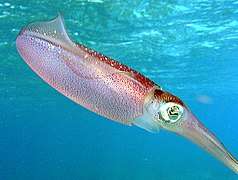Lophotrochozoa
Lophotrochozoa (/ləˌfɒtroʊkoʊˈzoʊə/, "crest/wheel animals") is a clade of protostome animals within the Spiralia. The taxon was established as a monophyletic group based on molecular evidence.[2][3]
| Lophotrochozoa | |
|---|---|
 | |
| Caribbean reef squid or Sepioteuthis sepioidea is a complex lophotrochozoan | |
| Scientific classification | |
| Kingdom: | Animalia |
| Clade: | ParaHoxozoa |
| Clade: | Bilateria |
| Clade: | Nephrozoa |
| (unranked): | Protostomia |
| (unranked): | Spiralia |
| Superphylum: | Lophotrochozoa Halanych et al., 1995 |
| Phyla | |
| |
Groups
The Lophotrochozoa has basal Cycliophora and Mollusca groups, and more derived Lophophorate, Nemertea and Annelida groups.[4][5]
With the introduction of Platytrochozoa and Rouphozoa, one candidate phylogeny is pictured below – though other studies recover a range of alternative possibilities:[6][7][8][9][10][11][12][13]
| Protostomes |
| |||||||||||||||||||||||||||||||||||||||||||||||||||||||||||||||||||||||||||||||||||||||
A number of fossil taxa can be identified as early Lophotrochozoans, even if their precise affinity remains contested. However, relevant Cambrian fossils are debated.
Characteristics
The clade Lophotrochozoa is named after the two distinct characteristics of its members; the feeding structure lophophore, which is a ciliated crown of tentacles surrounding a mouth, and the developmental stage trochophore larvae. Lophophorata such as Brachiozoa and Bryozoa have lophophores, while members of Trochozoa such as molluscs and annelids have trochophores, although some may have none.[14][15]
References
- Budd, Graham E.; Jackson, Illiam S. C. (January 5, 2016). "Ecological innovations in the Cambrian and the origins of the crown group phyla". Philosophical Transactions of the Royal Society B: Biological Sciences. 371 (1685): 20150287. doi:10.1098/rstb.2015.0287. PMC 4685591. PMID 26598735.
- Halanych, K.M., Bacheller, J., Liva, S., Aguinaldo, A. A., Hillis, D.M. and Lake, J.A. (17 March 1995). "18S rDNA evidence that the Lophophorates are Protostome Animals". Science. 267 (5204): 1641–1643. doi:10.1126/science.7886451. PMID 7886451.CS1 maint: multiple names: authors list (link)
- Hervé, Philippe; Lartillot, Nicolas; Brinkmann, Henner (May 2005). "Multigene Analyses of Bilaterian Animals Corroborate the Monophyly of Ecdysozoa, Lophotrochozoa, and Protostomia". Molecular Biology and Evolution. 22 (5): 1246–1253. doi:10.1093/molbev/msi111. PMID 15703236.
- Nesnidal, Maximilian P; Helmkampf, Martin; Meyer, Achim; Witek, Alexander; Bruchhaus, Iris; Ebersberger, Ingo; Hankeln, Thomas; Lieb, Bernhard; Struck, Torsten H; Hausdorf, Bernhard (2013). "New phylogenomic data support the monophyly of Lophophorata and an Ectoproct-Phoronid clade and indicate that Polyzoa and Kryptrochozoa are caused by systematic bias". BMC Evolutionary Biology. 13 (1): 253. doi:10.1186/1471-2148-13-253. PMC 4225663. PMID 24238092.
- Laumer, Christopher E.; Bekkouche, Nicolas; Kerbl, Alexandra; Goetz, Freya; Neves, Ricardo C.; Sørensen, Martin V.; Kristensen, Reinhardt M.; Hejnol, Andreas; Dunn, Casey W.; Giribet, Gonzalo; Worsaae, Katrine (August 2015). "Spiralian Phylogeny Informs the Evolution of Microscopic Lineages". Current Biology. 25 (15): 2000–2006. doi:10.1016/j.cub.2015.06.068. PMID 26212884. no-break space character in
|first5=at position 8 (help); no-break space character in|first1=at position 12 (help); no-break space character in|first6=at position 7 (help); no-break space character in|first7=at position 10 (help); no-break space character in|first9=at position 6 (help) - Paps, Jordi; Baguñà, Jaum; Riutort, Marta (2009-10-01). "Bilaterian Phylogeny: A Broad Sampling of 13 Nuclear Genes Provides a New Lophotrochozoa Phylogeny and Supports a Paraphyletic Basal Acoelomorpha". Molecular Biology and Evolutio. 26 (10): 2397–2406. doi:10.1093/molbev/msp150. PMID 19602542.
- Struck, Torsten H; Schult, Nancy; Kusen, Tiffany; Hickman, Emily; Bleidorn, Christoph; McHugh, Damhnait; Halanych, Kenneth M (5 April 2007). "Annelid phylogeny and the status of Sipuncula and Echiura". BMC Evolutionary Biology. 7 (1): 57. doi:10.1186/1471-2148-7-57. PMC 1855331. PMID 17411434.
- Hausdorf, Bernhard; Helmkampf, Martin; Meyer, Achim; Witek, Alexander; Herlyn, Holger; Bruchhaus, Iris; Hankeln, Thomas; Struck, Torsten H.; Lieb, Bernhard (2007-12-01). "Spiralian Phylogenomics Supports the Resurrection of Bryozoa Comprising Ectoprocta and Entoprocta". Molecular Biology and Evolution. 24 (12): 2723–2729. doi:10.1093/molbev/msm214. PMID 17921486.
- Struck, Torsten H.; Wey-Fabrizius, Alexandra R.; Golombek, Anja; Hering, Lars; Weigert, Anne; Bleidorn, Christoph; Klebow, Sabrina; Iakovenko, Nataliia; Hausdorf, Bernhard; Petersen, Malte; Kück, Patrick; Herlyn, Holger; Hankeln, Thomas (July 2014). "Platyzoan Paraphyly Based on Phylogenomic Data Supports a Noncoelomate Ancestry of Spiralia". Molecular Biology and Evolution. 31 (7): 1833–1849. doi:10.1093/molbev/msu143. PMID 24748651.
- "cycliophorans". Encyclopedia of Life.
- Lu, Tsai-Ming; Kanda, Miyuki; Satoh, Noriyuki; Furuya, Hidetaka (29 May 2017). "The phylogenetic position of dicyemid mesozoans offers insights into spiralian evolution". Zoological Letters. 3 (1): 6. doi:10.1186/s40851-017-0068-5. PMC 5447306. PMID 28560048.
- Temereva, Elena N.; Kuzmina, Tatyana V. (31 July 2017). "The first data on the innervation of the lophophore in the rhynchonelliform brachiopod Hemithiris psittacea: what is the ground pattern of the lophophore in lophophorates?". BMC Evolutionary Biology. 17 (1): 172. doi:10.1186/s12862-017-1029-5. PMC 5537927. PMID 28760135.
- Luo, Yi-Jyun; Kanda, Miyuki; Koyanagi, Ryo; Hisata, Kanako; Akiyama, Tadashi; Sakamoto, Hirotaka; Sakamoto, Tatsuya; Satoh, Noriyuki (4 December 2017). "Nemertean and phoronid genomes reveal lophotrochozoan evolution and the origin of bilaterian heads". Nature Ecology & Evolution. 2 (1): 141–151. doi:10.1038/s41559-017-0389-y. PMID 29203924.
- Barnes, Robert D (1982). Invertebrate Zoology. pp. 200–206. ISBN 978-0-03-056747-6. OCLC 1015202568.
- Reece, Jane B.; Urry, Lisa A.; Cain, Michael L. (2013). Campbell Biology. Berkeley, CA: Pearson. p. 688. ISBN 978-0-321-77565-8.
Further reading
| Wikispecies has information related to Lophotrochozoa |
- Podsiadlowski, Lars; Braband, Anke; Struck, Torsten H; von Döhren, Jörn; Bartolomaeus, Thomas (2009). "Phylogeny and mitochondrial gene order variation in Lophotrochozoa in the light of new mitogenomic data from Nemertea". BMC Genomics. 10 (1): 364. doi:10.1186/1471-2164-10-364. PMC 2728741. PMID 19660126.